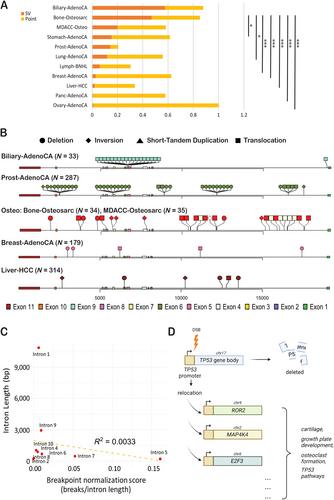下载PDF
{"title":"TP53 内含子结构变异的模式和 TP53 启动子的迁移:评论†。","authors":"Hannah C Beird, Dimitri Lin, Alexander J Lazar, P Andrew Futreal","doi":"10.1002/path.6270","DOIUrl":null,"url":null,"abstract":"<p>Gene disruption from double-strand DNA breaks within introns is a mechanism of inactivating the tumor suppressor <i>TP53</i>. This occurs more frequently in osteosarcoma and biliary adenocarcinoma compared with other cancer types. The patterns of intron breakpoints within <i>TP53</i> do not correlate with prevalence, intron length, or overall genome-wide levels of rearrangements. Therefore, these breakpoints appear to be selected for reasons other than to disrupt <i>TP53</i>. A recent article published by Saba <i>et al</i> in <i>The Journal of Pathology</i> illustrates a benefit to having breakpoints within intron 1 using high-quality matched genomic and transcriptomic osteosarcoma sequencing data as well as <i>in vitro</i> validation. The authors describe how the rearrangement results in relocation of the <i>TP53</i> promoter region to regions upstream of genes that encode members of cartilage, growth plate development, osteoclast formation, and other <i>TP53</i>-related pathways. The upregulation of these genes by the <i>TP53</i> promoter are gain-of-function events that are likely to promote tumor development and growth. Therefore, this article presents a potential new paradigm in which a single mutation would result in both the loss of a tumor suppressor and the gain of an oncogenic program. © 2024 The Authors. <i>The Journal of Pathology</i> published by John Wiley & Sons Ltd on behalf of The Pathological Society of Great Britain and Ireland.</p>","PeriodicalId":232,"journal":{"name":"The Journal of Pathology","volume":"263 2","pages":"131-134"},"PeriodicalIF":5.6000,"publicationDate":"2024-03-14","publicationTypes":"Journal Article","fieldsOfStudy":null,"isOpenAccess":false,"openAccessPdf":"https://onlinelibrary.wiley.com/doi/epdf/10.1002/path.6270","citationCount":"0","resultStr":"{\"title\":\"Patterns of structural variants within TP53 introns and relocation of the TP53 promoter: a commentary†\",\"authors\":\"Hannah C Beird, Dimitri Lin, Alexander J Lazar, P Andrew Futreal\",\"doi\":\"10.1002/path.6270\",\"DOIUrl\":null,\"url\":null,\"abstract\":\"<p>Gene disruption from double-strand DNA breaks within introns is a mechanism of inactivating the tumor suppressor <i>TP53</i>. This occurs more frequently in osteosarcoma and biliary adenocarcinoma compared with other cancer types. The patterns of intron breakpoints within <i>TP53</i> do not correlate with prevalence, intron length, or overall genome-wide levels of rearrangements. Therefore, these breakpoints appear to be selected for reasons other than to disrupt <i>TP53</i>. A recent article published by Saba <i>et al</i> in <i>The Journal of Pathology</i> illustrates a benefit to having breakpoints within intron 1 using high-quality matched genomic and transcriptomic osteosarcoma sequencing data as well as <i>in vitro</i> validation. The authors describe how the rearrangement results in relocation of the <i>TP53</i> promoter region to regions upstream of genes that encode members of cartilage, growth plate development, osteoclast formation, and other <i>TP53</i>-related pathways. The upregulation of these genes by the <i>TP53</i> promoter are gain-of-function events that are likely to promote tumor development and growth. Therefore, this article presents a potential new paradigm in which a single mutation would result in both the loss of a tumor suppressor and the gain of an oncogenic program. © 2024 The Authors. <i>The Journal of Pathology</i> published by John Wiley & Sons Ltd on behalf of The Pathological Society of Great Britain and Ireland.</p>\",\"PeriodicalId\":232,\"journal\":{\"name\":\"The Journal of Pathology\",\"volume\":\"263 2\",\"pages\":\"131-134\"},\"PeriodicalIF\":5.6000,\"publicationDate\":\"2024-03-14\",\"publicationTypes\":\"Journal Article\",\"fieldsOfStudy\":null,\"isOpenAccess\":false,\"openAccessPdf\":\"https://onlinelibrary.wiley.com/doi/epdf/10.1002/path.6270\",\"citationCount\":\"0\",\"resultStr\":null,\"platform\":\"Semanticscholar\",\"paperid\":null,\"PeriodicalName\":\"The Journal of Pathology\",\"FirstCategoryId\":\"3\",\"ListUrlMain\":\"https://onlinelibrary.wiley.com/doi/10.1002/path.6270\",\"RegionNum\":2,\"RegionCategory\":\"医学\",\"ArticlePicture\":[],\"TitleCN\":null,\"AbstractTextCN\":null,\"PMCID\":null,\"EPubDate\":\"\",\"PubModel\":\"\",\"JCR\":\"Q1\",\"JCRName\":\"ONCOLOGY\",\"Score\":null,\"Total\":0}","platform":"Semanticscholar","paperid":null,"PeriodicalName":"The Journal of Pathology","FirstCategoryId":"3","ListUrlMain":"https://onlinelibrary.wiley.com/doi/10.1002/path.6270","RegionNum":2,"RegionCategory":"医学","ArticlePicture":[],"TitleCN":null,"AbstractTextCN":null,"PMCID":null,"EPubDate":"","PubModel":"","JCR":"Q1","JCRName":"ONCOLOGY","Score":null,"Total":0}
引用次数: 0
引用
批量引用


 求助内容:
求助内容: 应助结果提醒方式:
应助结果提醒方式:


